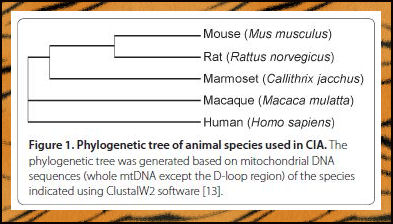Rheumatoid Arthritis Research Using Marmosets as Subjects
Why a new preclinical model for Rheumatoid Arthritis research?
Based upon “increasing knowledge of the pathogenesis of Rheumatoid Arthritis (RA),” more possible treatments are being developed. However animal models are required to evaluate the safety, effectiveness, and toxicity of many new potential RA treatments.
Rodent populations with RA-like disease are created by something called collagen-induced arthritis or CIA which behaves similarly to Rheumatoid Arthritis within the cells, creating synovitis and erosions. Therefore, that is the most widely used model for Rheumatoid Arthritis research. Rodent (mice and rat) models have been used extensively, as regular readers probably know. Don’t you love that CIA double connotation? These are investigative mice, eh?
Advantages of marmosets for Rheumatoid Arthritis research
Of course, there are years of clinical studies (on humans) of new RA treatments before they are approved for use. But recently, investigators in Germany have looked at using small mammals for some pre-clinical Rheumatoid Arthritis research. There would be obvious advantages of mammals over rodents because “the differences between rodents and humans limit their usability for some species-specific therapeutics.”
As the illustration shows, the macaque appears to have more in common with humans. However, the CIA produced in the macaque did not develop as frequently into an RA-like disease. Researchers have found that about half of treated marmosets developed a chronic arthritis disease and had the added advantage of being born as twins. So, experiments could be created where one twin could be tested with the new treatment and one could receive placebo. More studies are needed to evaluate the new model further.
Click here to read more about this novel preclinical model for Rheumatoid Arthritis research.





We have long needed better animal models for several diseases. The marmoset provides many good opportunities for meaningful and significant research. BUT – the Marmoset is not a perfect model, and some studies will not be fruitful. This is why we will always need studies in human populations.
Nevertheless, I am very pleased that there is a better animal model for in vivo studies. I hope that many good facts can be learned and good leads for earlier detection and treatments will be found.
Pingback: Tweets that mention Rheumatoid Arthritis Research Using Marmosets as Subjects | RA Education | Rheumatoid Arthritis Warrior -- Topsy.com
Testing on animals. Something I find distasteful. Making another living thing suffer. Nope. Seems wrong to trade torturing an animal for my own health problems.
For the marmoset model to take off it would have to demonstrate that it is superior in its prediction of human efficacy over other, more established models. There are numerous logistical challenges with using nonhuman primates over mice and rats. Different housing and animal care and use protocols. Not to mention the cost and availability of marmosets. I would say that most of these challenges and others would make it prohibitive for its use in lead optimization.